The global elderly safety monitoring device market, valued at USD 754.1 million in 2025 and forecasted to reach USD 1,350.5 million by 2035 at a CAGR of 6.0%, highlights strong transformation across elderly care ecosystems. Several key trends are shaping this trajectory and redefining monitoring solutions for aging populations.
One major trend is the shift toward AI-powered monitoring systems. Devices are increasingly designed with machine learning algorithms that analyze movement, detect anomalies, and provide predictive alerts for potential health issues. These features extend beyond fall detection to include heart rate tracking, sleep monitoring, and daily activity analysis, reinforcing their role as comprehensive health tools. Integration of wearable technologies with smart home platforms enhances this functionality, enabling continuous observation in both individual residences and institutional settings.
Another critical trend is the integration with healthcare infrastructure. Safety monitoring devices are moving from standalone gadgets to becoming part of larger healthcare ecosystems. Cloud-based platforms now allow physicians and caregivers to remotely track elderly patients, reducing hospital visits while improving continuity of care. Interoperability with electronic health records (EHRs) and telehealth services is gaining traction, ensuring data consistency and smoother communication between families, caregivers, and healthcare providers.
The market is also being shaped by demand for real-time emergency response solutions. Features such as GPS-enabled tracking, automatic emergency calls, and connected alarm systems are becoming standard. This enhances both patient safety and caregiver confidence, especially for elderly individuals living independently. Voice-enabled assistance and two-way communication devices are expanding adoption by providing ease of use for less tech-savvy users. Regional dynamics indicate that North America and Europe lead adoption due to aging demographics and advanced healthcare frameworks, while Asia Pacific is emerging as a high-growth region driven by rising elderly populations and increasing affordability of smart devices. Affordability and accessibility remain crucial, pushing manufacturers to develop flexible pricing models and subscription-based services. Another rising trend is the fusion of elderly monitoring with lifestyle and wellness management. Devices now offer reminders for medication adherence, hydration tracking, and even cognitive engagement tools, making them holistic care companions rather than just emergency systems.
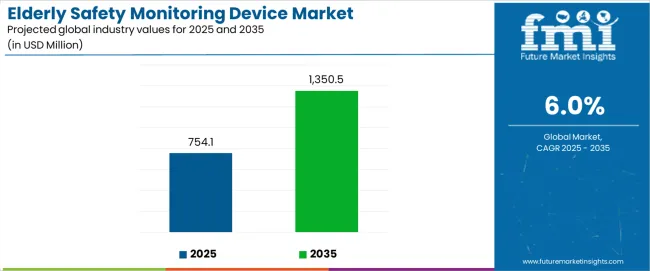
The elderly safety monitoring device market demonstrates distinct growth phases with varying market characteristics and competitive dynamics. Between 2025 and 2030, the market progresses through its advanced technology adoption phase, expanding from USD 754.1 million to USD 975.2 million with steady annual increments averaging 5.3% growth. This period showcases the transition from basic alert systems to advanced ai-powered monitoring platforms with enhanced detection capabilities and integrated health tracking becoming mainstream features.
The 2025-2030 phase adds USD 221.1 million to market value, representing 37% of total decade expansion. Market maturation factors include standardization of monitoring protocols, declining costs for advanced sensor technology, and increasing family awareness of elderly safety benefits reaching 80-85% effectiveness in emergency response applications. Competitive landscape evolution during this period features established providers like GetSafe and One Call Alert expanding their service portfolios while new entrants focus on specialized wearable solutions and enhanced ai-driven monitoring technology.
From 2030 to 2035, market dynamics shift toward comprehensive care integration and multi-platform deployment, with growth accelerating from USD 975.2 million to USD 1,350.5 million, adding USD 375.3 million or 63% of total expansion. This phase transition logic centers on universal smart monitoring systems, integration with telehealth platforms, and deployment across diverse care scenarios, becoming standard rather than specialized safety formats. The competitive environment matures with focus shifting from basic alerts to comprehensive health monitoring and compatibility with modern healthcare management systems.
| Metric | Value |
|---|---|
| Market Value (2025) | USD 754.1 million |
| Market Forecast (2035) | USD 1,350.5 million |
| Growth Rate | 6.0% CAGR |
| Leading Alarm Type | Automatic Alarm |
| Primary Application | Family Segment |
The market demonstrates strong fundamentals with automatic alarm systems capturing a dominant share through superior detection capabilities and reliable emergency response features. Family applications drive primary demand, supported by increasing elderly population requirements and enhanced home-based monitoring solutions. Geographic expansion remains concentrated in developed markets with established healthcare infrastructure, while emerging economies show accelerating adoption rates driven by aging demographics and rising healthcare awareness activity.
The elderly safety monitoring device market represents a compelling intersection of healthcare innovation, sensor technology advancement, and elderly care optimization management. With robust growth projected from USD 754.1 million in 2025 to USD 1,350.5 million by 2035 at a 6.0% CAGR, this market is driven by aging population trends, healthcare cost reduction requirements, and family demand for reliable monitoring formats.
The market's expansion reflects a fundamental shift in how families and healthcare providers approach elderly care infrastructure. Strong growth opportunities exist across diverse applications, from home-based operations requiring everyday health monitoring to nursing facilities demanding comprehensive safety solutions. Geographic expansion is particularly pronounced in Asia-Pacific markets, led by China (8.1% CAGR) and India (7.5% CAGR), while established markets in North America and Europe drive innovation and specialized segment development.
The dominance of automatic alarm systems and family applications underscores the importance of proven monitoring technology and user-friendly reliability in driving adoption. Alert response time and system complexity remain key challenges, creating opportunities for companies that can deliver consistent performance while maintaining ease of use.
Market expansion rests on three fundamental shifts driving adoption across family and institutional care sectors. Demographic aging creates compelling advantages through monitoring systems that provide comprehensive safety oversight with real-time emergency response, enabling families to manage elderly care remotely while maintaining independence and justifying investment over traditional care methods. Healthcare cost reduction accelerates as providers worldwide seek efficient monitoring systems that deliver care coordination directly to home environments, enabling cost savings that align with healthcare budget expectations and maximizes patient safety outcomes. Population aging increases drive adoption from families requiring reliable safety solutions that maximize monitoring coverage while maintaining user comfort during daily activities and emergency situations.
The growth faces headwinds from technology complexity that differs across user demographics regarding ease of use and learning curves, potentially limiting adoption in less tech-savvy elderly populations. Privacy concerns also persist regarding health data collection and monitoring systems that may increase resistance in markets with demanding personal privacy preferences.
Primary Classification: The market segments by alarm type into automatic alarm, active alarm, and others categories, representing the evolution from basic manual systems to advanced ai-powered formats for comprehensive safety monitoring operations.
Secondary Breakdown: Application segmentation divides the market into family, nursing home, hospital, and others sectors, reflecting distinct requirements for monitoring capabilities, response protocols, and integration specifications.
Regional Classification: Geographic distribution covers North America, Europe, Asia Pacific, Latin America, and the Middle East & Africa, with developed markets leading innovation while emerging economies show accelerating growth patterns driven by aging population demographics.
The segmentation structure reveals technology progression from standard manual alerts toward integrated ai-powered platforms with enhanced detection and health monitoring capabilities, while application diversity spans from family operations to healthcare facilities requiring comprehensive safety management and emergency response solutions.
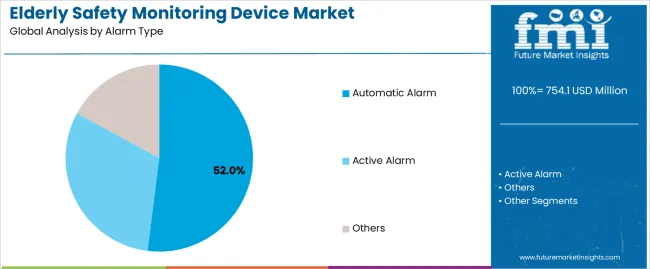
Automatic alarm segment is estimated to account for 52.0% of the elderly safety monitoring device market share in 2025. The segment's leading position stems from its fundamental role as a critical component in elderly safety applications and its extensive use across multiple family and institutional care sectors. Automatic alarm's dominance is attributed to its superior detection reliability, including excellent fall recognition, reliable emergency triggering, and balanced user convenience that make it indispensable for everyday elderly monitoring operations.
Market Position: Automatic alarm systems command the leading position in the elderly safety monitoring device market through advanced sensor technologies, including comprehensive motion detection, accurate health monitoring, and reliable alert performance that enable providers to deploy safety solutions across diverse care environments.
Value Drivers: The segment benefits from family preference for hands-free monitoring profiles that provide exceptional reliability without requiring constant user interaction. Efficient detection algorithms enable deployment in home monitoring, institutional care, and healthcare applications where detection accuracy and response reliability represent critical selection requirements.
Competitive Advantages: Automatic alarm systems differentiate through excellent predictive capabilities, proven emergency response, and compatibility with existing medical equipment that enhance safety outcomes while maintaining user-friendly operation suitable for diverse elderly care applications.
Key market characteristics:
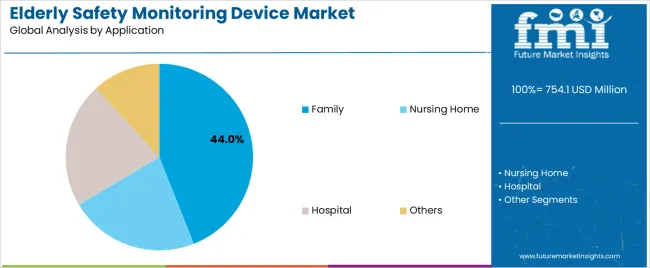
Family segment is projected to hold 44.0% of the elderly safety monitoring device market share in 2025. The segment's market leadership is driven by the extensive use of monitoring devices in home-based elderly care, independent living support, and family peace-of-mind applications, where safety systems serve as both a protection barrier and convenience solution. The family sector's consistent demand for reliable monitoring devices supports the segment's dominant position.
Market Context: Family applications dominate the market due to widespread adoption of home-based care solutions and increasing focus on aging in place, emergency prevention, and health monitoring that enhance quality of life while maintaining independence standards.
Appeal Factors: Family caregivers prioritize ease of use, reliable alerts, and integration with existing communication systems that enable coordinated care across multiple family members. The segment benefits from substantial aging population growth and care preference shifts that emphasize reliable monitoring systems for home-based elderly applications.
Growth Drivers: Home healthcare programs incorporate safety devices as standard components for independent living and family care programs. At the same time, caregiver support initiatives are increasing demand for premium features that comply with medical standards and enhance family communication.
Market Challenges: Technology adoption barriers and cost considerations may limit deployment flexibility in price-sensitive markets or families with varying technical comfort levels.
Application dynamics include:
Growth Accelerators: Population aging drives primary adoption as elderly safety monitoring systems provide exceptional care capabilities that enable independent living without compromising safety, supporting family peace of mind and healthcare cost reduction that require reliable monitoring formats. Healthcare cost pressures accelerate market expansion as families seek efficient care solutions that maintain elderly independence while enhancing safety monitoring through real-time alerts and emergency response. Technology acceptance increases worldwide, creating sustained demand for user-friendly monitoring systems that complement daily routines and provide operational advantages in care coordination efficiency.
Growth Inhibitors: Technology complexity challenges differ across elderly demographics regarding comfort levels and learning curves, which may limit adoption rates and user satisfaction in less tech-savvy elderly populations with demanding simplicity requirements. Privacy concerns persist regarding health data monitoring and emergency response systems that may increase resistance in populations with strict personal privacy protocols. Market fragmentation across multiple device types and service models creates compatibility concerns between different monitoring systems and existing healthcare infrastructure.
Market Evolution Patterns: Adoption accelerates in family and healthcare sectors where safety benefits justify technology investments, with geographic concentration in developed markets transitioning toward mainstream adoption in emerging economies driven by aging demographics and healthcare development. Technology advancement focuses on enhanced AI capabilities, improved user interfaces, and integration with comprehensive healthcare platforms that optimize monitoring performance and care coordination. The market could face disruption if alternative care monitoring methods or regulatory changes significantly challenge traditional device advantages in elderly safety applications.
The elderly safety monitoring device market demonstrates varied regional dynamics with growth leaders including China (8.1% CAGR) and India (7.5% CAGR) driving expansion through aging population growth and healthcare modernization. Steady Performers encompass Germany (6.9% CAGR), Brazil (6.3% CAGR), the USA (5.7% CAGR), the UK (5.1% CAGR), and Japan (4.5% CAGR), benefiting from established healthcare systems and family care adoption.
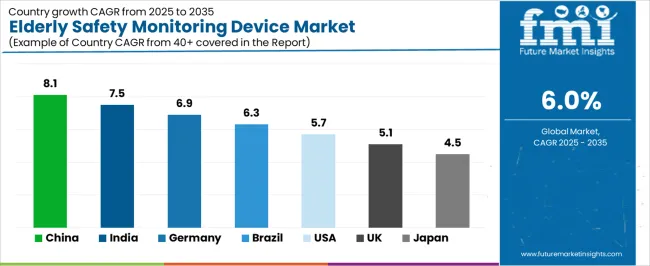
| Country | CAGR (2025-2035) |
|---|---|
| China | 8.1% |
| India | 7.5% |
| Germany | 6.9% |
| Brazil | 6.3% |
| USA | 5.7% |
| UK | 5.1% |
| Japan | 4.5% |
Regional synthesis reveals Asia-Pacific markets leading growth through demographic transitions and healthcare development, while European countries maintain steady expansion supported by specialized applications and aging population requirements. North American markets show strong growth driven by family demand and healthcare facility upgrades.
China establishes regional leadership through rapid population aging and comprehensive healthcare modernization, integrating advanced elderly safety monitoring systems as standard components in family care and institutional healthcare operations. The country's 8.1% CAGR through 2035 reflects demographic shifts promoting elderly care infrastructure and healthcare technology development that mandate the use of reliable monitoring systems in aging care operations. Growth concentrates in major urban centers, including Beijing, Shanghai, and Guangzhou, where healthcare networks showcase integrated monitoring systems that appeal to families seeking enhanced care coordination and international healthcare standards.
Chinese manufacturers are developing innovative elderly monitoring solutions that combine local production advantages with international technology specifications, including ai-powered detection and advanced emergency response capabilities.
Strategic Market Indicators:
The Indian market emphasizes family care applications, including rapid urbanization and comprehensive healthcare expansion that increasingly incorporates elderly safety devices for home monitoring and family peace-of-mind applications. The country is projected to show a 7.5% CAGR through 2035, driven by massive demographic shifts under healthcare modernization initiatives and family demand for reliable, affordable monitoring systems. Indian healthcare facilities prioritize cost-effectiveness with safety devices delivering care coordination through economical technology usage and reliable performance capabilities.
Technology deployment channels include major healthcare providers, family care services, and urban developers that support high-volume usage for domestic and institutional applications.
Performance Metrics:
The German market emphasizes advanced monitoring features, including innovative sensor technologies and integration with comprehensive healthcare platforms that manage home care, institutional monitoring, and family care applications through unified safety systems. The country is projected to show a 6.9% CAGR through 2035, driven by aging population trends under healthcare excellence initiatives and family demand for premium, reliable monitoring systems. German families prioritize quality with safety devices delivering comprehensive care management through enhanced detection capabilities and operational innovation.
Technology deployment channels include major healthcare insurers, elderly care providers, and family care services that support custom development for premium operations.
Performance Metrics:
In São Paulo, Rio de Janeiro, and Brasília, Brazilian healthcare providers and family care services are implementing advanced elderly safety monitoring systems to enhance care capabilities and support operational efficiency that aligns with healthcare protocols and family care standards. The Brazilian market demonstrates sustained growth with a 6.3% CAGR through 2035, driven by healthcare accessibility programs and family investments that emphasize affordable monitoring systems for home-based and institutional care applications. Brazilian healthcare facilities are prioritizing safety devices that provide exceptional care coordination while maintaining cost-effectiveness and minimizing technology complexity, particularly important in family care and healthcare facility operations.
Market expansion benefits from healthcare programs that mandate enhanced elderly care in safety specifications, creating sustained demand across Brazil's family and healthcare sectors, where affordability and ease of use represent critical requirements.
Strategic Market Indicators:
The USA market emphasizes advanced elderly safety monitoring features, including innovative AI technologies and integration with comprehensive healthcare platforms that manage home care, assisted living, and family applications through unified monitoring systems. The country is projected to show a 5.7% CAGR through 2035, driven by healthcare cost management under aging population trends and family demand for premium, reliable monitoring systems. American families prioritize convenience with safety devices delivering comprehensive elderly care through enhanced emergency response and operational innovation.
Technology deployment channels include major healthcare insurers, elderly care providers, and family care services that support custom development for premium operations.
Performance Metrics:
The UK market emphasizes healthcare system integration, including comprehensive monitoring solutions and healthcare platform compatibility that manage NHS care, private healthcare, and family applications through unified safety systems. The country is projected to show a 5.1% CAGR through 2035, driven by healthcare efficiency programs and aging population support that emphasizes reliable monitoring systems for home-based and institutional applications. British healthcare facilities prioritize monitoring devices that provide exceptional care coordination while maintaining NHS compatibility and minimizing healthcare costs, particularly important in public healthcare and family care operations.
Market expansion benefits from healthcare programs that mandate enhanced elderly monitoring in care specifications, creating sustained demand across the UK's healthcare and family sectors, where reliability and system integration represent critical requirements.
Market Intelligence Brief:
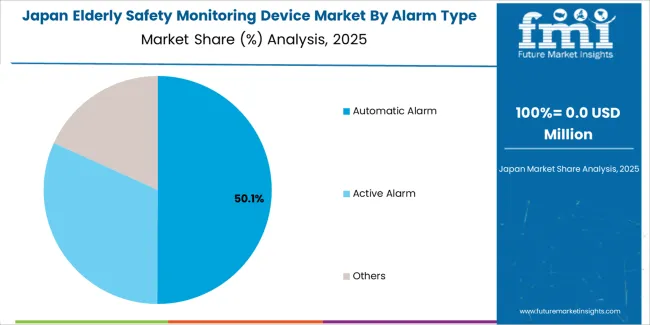
Japan's sophisticated elderly care market demonstrates meticulous monitoring device deployment, growing at 4.5% CAGR, with documented operational excellence in family care and healthcare applications through integration with existing elderly care systems and quality assurance infrastructure. The country leverages engineering expertise in sensor manufacturing and healthcare technology to maintain market leadership. Care centers, including Tokyo, Osaka, and Kyoto, showcase advanced installations where monitoring systems integrate with comprehensive care platforms and healthcare systems to optimize elderly safety and operational efficiency.
Japanese healthcare facilities prioritize monitoring precision and technology reliability in device selection, creating demand for premium elderly safety systems with advanced features, including ultra-sensitive sensors and integration with robotic care protocols. The market benefits from established healthcare infrastructure and willingness to invest in specialized monitoring technologies that provide superior detection capabilities and healthcare compliance.
Market Intelligence Brief:
The elderly safety monitoring device market in Europe is projected to grow from USD 162.1 million in 2025 to USD 241.7 million by 2035, registering a CAGR of 4.1% over the forecast period. Germany is expected to maintain its leadership position with a 42.3% market share in 2025, declining slightly to 41.8% by 2035, supported by its healthcare excellence and major elderly care centers, including North Rhine-Westphalia and Bavaria.
United Kingdom follows with a 28.7% share in 2025, projected to reach 29.1% by 2035, driven by comprehensive NHS programs and family care initiatives. France holds a 16.2% share in 2025, expected to maintain 16.5% by 2035 through established healthcare sectors and elderly care adoption. Italy commands an 8.3% share, while Spain accounts for 3.9% in 2025. The Rest of Europe region is anticipated to gain momentum, expanding its collective share from 0.6% to 1.1% by 2035, attributed to increasing aging population in Eastern European countries and emerging healthcare programs implementing standardized elderly care systems.
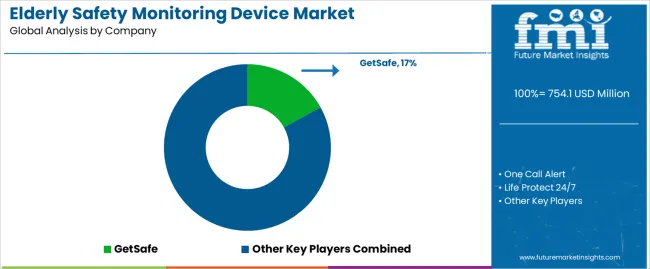
The elderly safety monitoring device market operates with moderate concentration, featuring approximately 15-22 participants, where leading companies control roughly 38-45% of the global market share through established service networks and comprehensive monitoring solution capabilities. Competition emphasizes detection accuracy, response reliability, and user experience rather than premium technology rivalry.
Market leaders encompass GetSafe, One Call Alert, and Life Protect 24/7, which maintain competitive advantages through extensive monitoring service expertise, global response networks, and comprehensive technical support capabilities that create family loyalty and support healthcare requirements. These companies leverage decades of emergency response experience and ongoing technology investments to develop advanced monitoring systems with exceptional detection and communication features.
Specialty challengers include Medical Alert, MobileHelp, and Bay Alarm Medical, which compete through specialized application innovation focus and efficient service solutions that appeal to healthcare buyers seeking reliable performance formats and custom monitoring flexibility. These companies differentiate through operational efficiency emphasis and specialized market focus.
Market dynamics favor participants that combine consistent monitoring performance with advanced service support, including 24/7 response centers and healthcare integration capabilities. Competitive pressure intensifies as traditional healthcare companies expand into monitoring systems. At the same time, specialized technology providers challenge established players through innovative AI algorithms and cost-effective solutions targeting emerging family care segments.
| Item | Value |
|---|---|
| Quantitative Units | USD 754.1 million |
| Alarm Type | Automatic Alarm, Active Alarm, Others |
| Application | Family, Nursing Home, Hospital, Others |
| Technology Type | Wearable Devices, Home Sensors, Mobile Apps, Smart Home Integration |
| Service Type | Monitoring Services, Emergency Response, Health Tracking, Medication Reminders |
| Regions Covered | North America, Europe, Asia Pacific, Latin America, Middle East & Africa |
| Countries Covered | China, India, Germany, Brazil, USA, UK, Japan, and 25+ additional countries |
| Key Companies Profiled | GetSafe, One Call Alert, Life Protect 24/7, Medical Alert, MobileHelp, Bay Alarm Medical |
| Additional Attributes | Dollar sales by alarm type and application categories, regional adoption trends across Asia Pacific, North America, and Europe, competitive landscape with monitoring service providers and technology manufacturers, family preferences for detection capabilities and response reliability, integration with healthcare systems and emergency services, innovations in AI detection technology and sensor systems, and development of specialized monitoring solutions with enhanced accuracy and health tracking features |
The global elderly safety monitoring device market is estimated to be valued at USD 754.1 million in 2025.
The market size for the elderly safety monitoring device market is projected to reach USD 1,350.5 million by 2035.
The elderly safety monitoring device market is expected to grow at a 6.0% CAGR between 2025 and 2035.
The key product types in elderly safety monitoring device market are automatic alarm , active alarm and others.
In terms of application, family segment to command 44.0% share in the elderly safety monitoring device market in 2025.






Full Research Suite comprises of:
Market outlook & trends analysis
Interviews & case studies
Strategic recommendations
Vendor profiles & capabilities analysis
5-year forecasts
8 regions and 60+ country-level data splits
Market segment data splits
12 months of continuous data updates
DELIVERED AS:
PDF EXCEL ONLINE
Safety Bottle Tote Carriers Packaging Market Size and Share Forecast Outlook 2025 to 2035
Safety Towing System Market Size and Share Forecast Outlook 2025 to 2035
Safety Syringe Market Size and Share Forecast Outlook 2025 to 2035
Safety Actuators Market Size and Share Forecast Outlook 2025 to 2035
Safety Needles Market Size and Share Forecast Outlook 2025 to 2035
Safety Laser Scanner Market Size and Share Forecast Outlook 2025 to 2035
Safety Limit Switches Market Size and Share Forecast Outlook 2025 to 2035
Safety Reporting Systems Market Size and Share Forecast Outlook 2025 to 2035
Safety Eyewear Market Analysis - Size, Share, and Forecast 2025 to 2035
Safety Box for Syringe Market Size, Share & Forecast 2025 to 2035
Safety Valve Market Size, Growth, and Forecast 2025 to 2035
Safety Relays Market Size, Share, and Forecast 2025 to 2035
Safety Instrumentation Systems Market – Trends & Forecast 2025 to 2035
Safety Mirrors Market - Growth & Forecast 2025 to 2035
Safety Switches Market Trends – Growth & Forecast 2025 to 2035
Safety Interlock Switches Market Analysis by Actuation Method, Application and End-use Industry and Region 2025 to 2035
Safety Light Curtains Market Growth - Trends & Forecast 2025 to 2035
Key Companies & Market Share in the Safety Eyewear Sector
Industry Share Analysis for Safety Box for Syringe Companies
Safety Label Market Growth & Industry Demand 2024-2034

Thank you!
You will receive an email from our Business Development Manager. Please be sure to check your SPAM/JUNK folder too.
Chat With
MaRIA